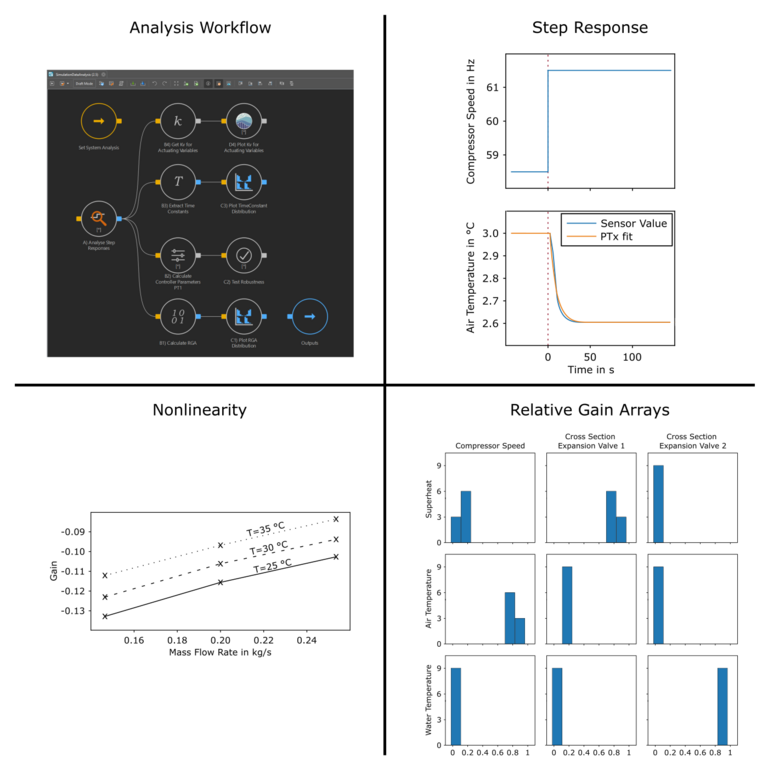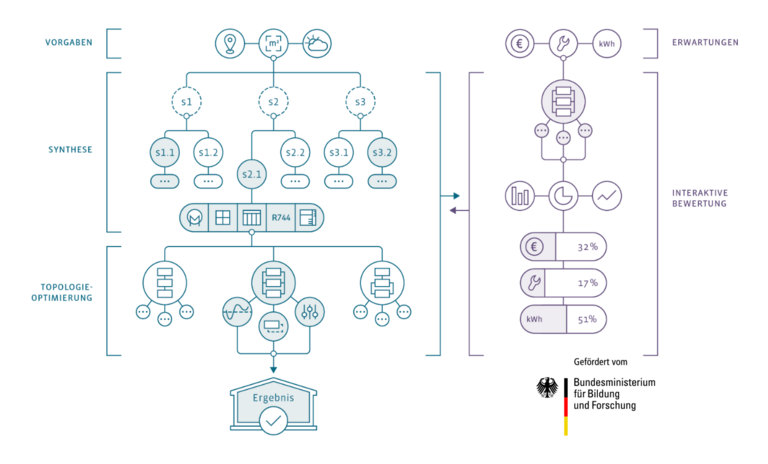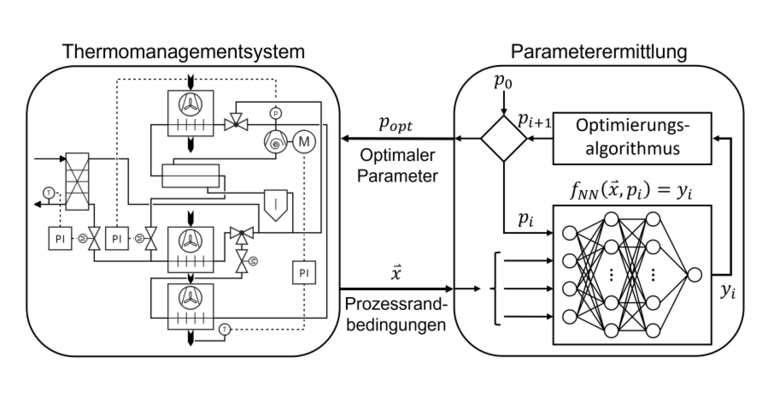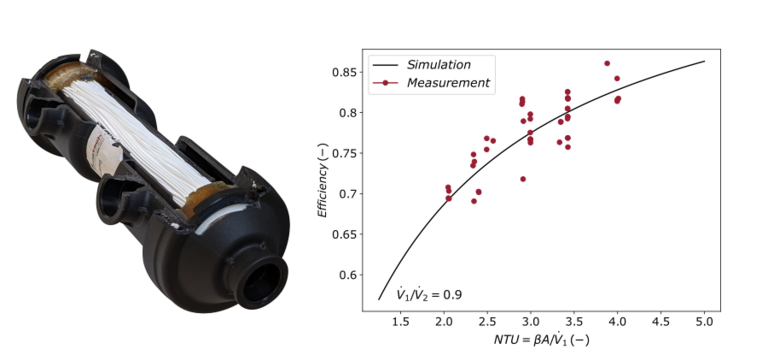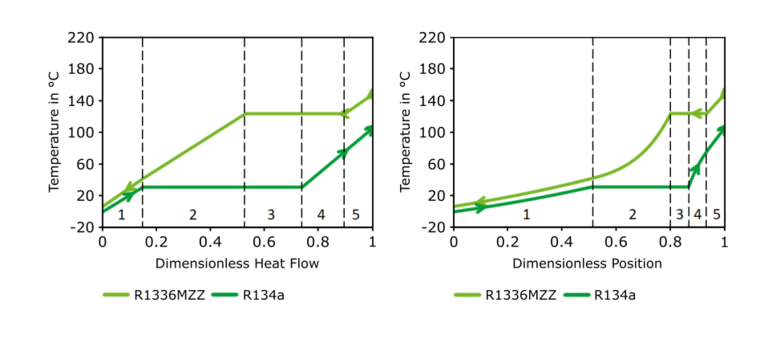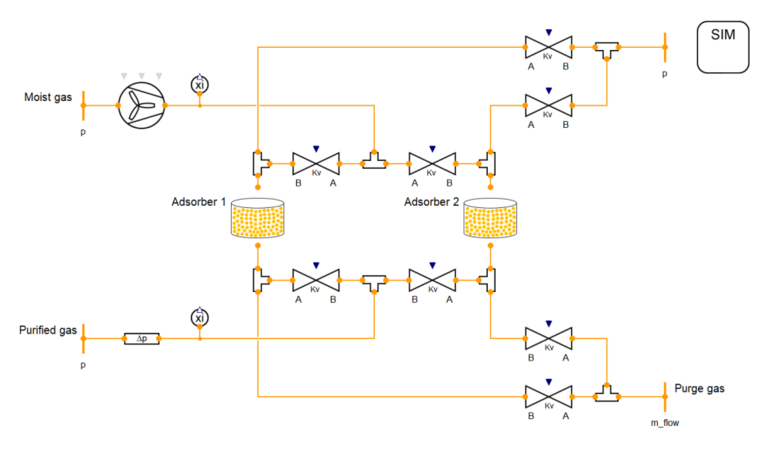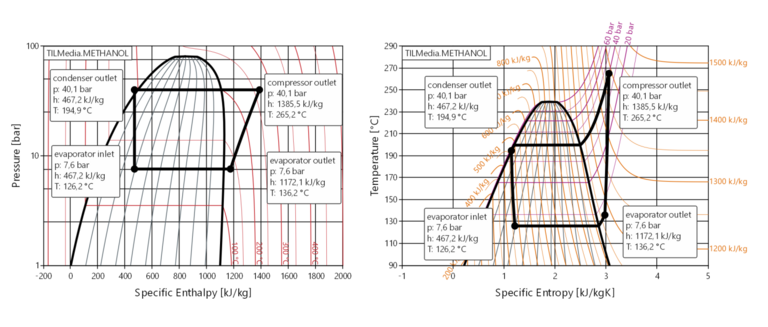Newsletter April 2022
With the new MoBA 3.0 add-on library "Control Oriented Analysis", a control system analysis can be carried out automatically on the basis of simulation or measurement data. For example, gain factors and time constants at various operating points can be evaluated from simulated step responses and suitable PID controller parameters can be calculated.
MoBA Automation Version 3.0
Our MoBA Automation software enables the automation of individual workflows for the model- or measurement data-supported development, analysis and optimization of technical systems. Version 3.0 will be available for download in April 2022. With this version, in addition to the TLK Standard Task Library, we also offer optional add-on libraries for special applications, including the "Control Oriented Analysis" add-on library for control system analysis.
Control-oriented system analysis
Systems, such as refrigeration systems in vehicles, have to operate in a large operating space. If this operating space has a large variance in ambient temperatures, volume flows at heat exchangers and power requirements and coupled control tasks are necessary at the same time, this situation requires coordinated controllers at all operating points. The following questions arise when designing these controllers:
Add-On Library "Control Oriented Analysis"
The MoBA Automation add-on library "Control Oriented Analysis" supports you with its workflows in answering the above questions. The starting point of the workflow can be either measurement data or simulation models. For the control-oriented analysis of a system model, the model must be modified in such a way that the operating point to be analyzed can be set, a step can be applied to an actuator, and the uncontrolled step response can be recorded. The workflow for control oriented analysis evaluates all step responses. It fits first order behavior, higher order behavior, and dead time using various methods. From this, gain factors and time constants can be determined. Nonlinearities can be quantified via the operating points. The evaluation - e.g., via relative gain arrays - allows the assignment of actuators to controlled variables. Furthermore, interactions between controlled variables can be represented in this way.
Parametrizing the controllers
Using the calculated system properties such as PTx behavior and the dead time, a workflow task determines the parameters for PI controllers using various methods and validates them on the model. All results of the workflow are summarized in a PowerPoint report.
Further innovations in MoBA Automation Version 3.0
In addition to control oriented system analysis, MoBA Automation Version 3.0 also offers other add-on libraries for further use cases, such as model reduction or machine learning, model regression testing, model validation, optimization, and measurement data evaluation. In addition, the new release contains numerous ergonomic improvements, such as an accelerated start of the task or better assistance when parameterizing complex workflows. Licensees will soon be receiving detailed information about the new version. A list of all new features of version 3.0 can also be found in the release notes.
Customized solutions for process automation
In addition to the standard tasks and the add-on libraries for special applications, we also offer our customers customized solutions on request, which can be used for individual automation tasks. Please contact us if you need support for the implementation of your workflows.
Your Feedback
We thank you for your valuable feedback, which has contributed significantly to the further development of MoBA. Of course, we will continue to work on improving the ergonomics of MoBA Automation with great enthusiasm. If you have any suggestions, please do not hesitate to contact us.
Contact Control Oriented System Analysis: Dr.-Ing. Andreas Varchmin
Contact MoBA Automation: Dr.-Ing. Philipp Ebeling
As part of the funded VEOTOP R&D project, which was completed in autumn 2021, TLK, together with Technische Universität Braunschweig, developed software tools for topology optimization of complex thermal energy systems.
The Topology of Thermal Energy Systems
Thermal energy systems must perform an ever-increasing number of thermal processes: cooling, heating, deep-freezing, air-conditioning, dehumidifying, etc. - and all under changing operating conditions! For the topology of the energy systems, i.e., the selection and combination of the technical components, there are an unmanageable number of options. To evaluate these topologies, concepts for operating strategy and control are also necessary.
VEOTOP
To address this need, TLK developed methods and software tools in the VEOTOP project, together with the Technische Universität Braunschweig (Labs for thermodynamics, control engineering and mathematical optimization), to design and optimize topologies and to evaluate them including operating and control strategies.
The newly created methods and tools make it possible to generate several topologies of a thermal system based on user specifications and to optimally design these topologies taking dynamic boundary conditions into account. The developed systems can then be automatically simulated and visualized.
We would like to thank the Federal Ministry of Education and Research for funding and supporting the project.
Effects of the results on TLK software
The newly developed methods and algorithms are incorporated into various TLK software products:
Contact: Dr.-Ing. Andreas Varchmin
Neural Networks for the Control of CO2 Refrigeration Cycles
Energy-Efficient Control for Optimized Operation
The use of neural networks to create computationally efficient surrogate models can produce high quality approximations to physics-based models. Through their use in the control of a CO2 refrigeration cycle, TLK was able to achieve COP-optimized operation as well as an improvement in system behavior during load changes.
The energy-efficient operation of thermal management systems through advanced control concepts is an important element of the vehicle of the future. As part of the PHyMoS (Proper Hybrid Models for Smarter Vehicles) research project, TLK is investigating the use of machine learning models for model-based control of thermal management systems for passenger cars. Compared to physical-mechanistic models, these models can be characterised by a significantly lower computational load for model evaluation, which is why their use is particularly advantageous when there is little available computing capacity.
TLK has investigated the use of neural networks to determine optimal process parameters and for model-based feedforward control of a CO2 refrigeration cycle.
Determination of optimal process parameters
The determination of optimal process parameters is a significant challenge for complex refrigeration cycles. Due to their high complexity, detailed physical-mechanistic models of refrigeration cycles are only suitable for online optimization to a very limited extent. Thus, optimization calculations are usually carried out separately and the results are stored - e.g., in the form of a characteristic diagram - for further use. The use of machine learning methods, on the other hand, enables online optimization calculations to be carried out on the basis of a reduced, approximate model of the refrigeration cycle. For this purpose, a neural network is trained to map the correlations between the process boundary conditions, the process parameter to be determined and the variable(s) that are relevant for the optimization task. This method, shown in Figure 1, was used to determine the optimal high pressure of a switchable CO2 refrigeration cycle with parallel evaporators. With the help of the neural network, the maximum possible COP (Coefficient of Performance) was achieved within a mean relative deviation of approximately 0.4 % compared to the simulatively determined maximum COP (tested for 80 random boundary conditions).
Figure 3: Determination of optimal process parameters of a CO2 refrigeration circuit with the aid of a neural network
Model-based feed forward control
A significant improvement of the control behaviour can be achieved by a model-based determination of the controllers’ actuating variables. Typically, simplifying model assumptions are made when creating surrogate models required for such a model-based feedforward control, which means that nonlinearities in the correlation between actuating variables and boundary conditions are unlikely to be represented adequately.
For this reason, TLK has tested the suitability of neural networks as approximate surrogate models for use in model-based feedforward control. A neural network was used for the feedforward control of the compressor speed of a CO2 thermal management system. This resulted in a significant improvement of the control behaviour compared to a simulatively designed PI controller. As a result, the maximum control error of the supply air temperature was reduced by 50 % when the air mass flow rate in the air conditioning unit was changed.
Provision of neural networks
TLK can provide the generated neural networks either as code in the programming language C or as a DLL. The neural networks can thus be integrated into both Modelica and Matlab/Simulink models or compiled and executed on any system.
Future research on machine learning methods
TLK is constantly researching and developing new ways of using various machine learning methods to solve control engineering problems. In particular, the determination of trajectories to improve control behaviour and the use for icing prevention are to be investigated more intensively in the future.
Contact Machine-Learning: M.Sc. Henrik Schatz
Contact Control: Dr.-Ing. Andreas Varchmin
News from the TLK Laboratory: Experiments with Membrane Humidifiers
Investigation and Optimization of the Water Balance in PEM Fuel Cells
For efficient operation and to promote long lifetimes of PEM fuel cells, a good water balance is crucial. To optimize this, membrane humidifiers are used in PEM fuel cell systems. TLK is investigating such membrane humidifiers on a complex test rig.
The thermodynamic losses of a fuel cell are significantly influenced by moisture-dependent proton conductivity. Water content also affects fuel cell degradation. To minimize thermodynamic losses as well as slow the degradation process, so-called membrane humidifiers are used.
In membrane humidifiers, water contained in the air is driven from the wet exhaust air to the dry supply air of the fuel cell by the moisture concentration gradient. The humidifier membrane used for this purpose is highly permeable to water, but blocks the transport of other gases.
In TLK's laboratory, the investigation of heat and mass transfer in membrane humidifiers under various boundary conditions - e.g., air mass flow rates, relative humidities, temperatures and pressures - is possible. The greatest challenge is to precisely adjust the mass flows and at the same time accurately measure the power. Even low quantities of only a few watts are relevant. And when it comes to balancing, every drop of water, no matter how small, counts.
In addition to individual investigations for our customers, TLK also carries out its own measurements as part of the publicly funded AUTO-GEN project. AUTO-GEN stands for "Partially automated generation of physics-based and data-based thermodynamic models for the design and operation of complex systems in e-mobility". In AUTO-GEN, among other things, humidifier models for fuel cell systems in commercial vehicles are created in collaboration with the Technische Universität Braunschweig (Markus Pollak, m.pollak@tu-braunschweig.de). The models are then validated with measurement data obtained from the test bench.
These humidification experimental investigations are just one example of the interaction between experiment and simulation at TLK. A wide variety of experimental investigations are carried out in labspace of around 1000m², both for our customers and for the optimization of our model libraries.
Contact: Dr.-Ing. Nicholas Lemke
The next release of TIL Suite 3.12.0 for the simulation of thermal systems will be available in April 2022. Many add-ons - new as well as extended - offer additional application possibilities in the areas of heat exchangers, adsorption, hydrogen energy systems, automotive, and heat storage.
The TIL Suite provides versatile thermal component and system models for steady-state and transient simulations. Some of the essential innovations of the TIL Suite 3.12.0, which will be released in April, are presented in the following. Several add-ons are new, while others have been extended. There are also improvements in the TIL Suite Basic and TILMedia. Compatibility with Modelon Impact and OpenModelica has been improved for the entire TIL Suite.
Add-On NTU-HX
The new add-on NTU-HX provides heat transfer models with particularly high computational speed. For this purpose, a new calculation methodology is used, which TLK has developed together with the Lab for Thermodynamics at the Technische Universität Braunschweig (Hamidreza Hassani, h.hassani-khab-bin@tu-braunschweig.de) on the basis of the NTU approach. The analytical calculation methodology used means that the temperature curves within the heat exchangers can be mapped with a high degree of accuracy, even for phase change phenomena. A comparable accuracy is also possible with the heat exchanger models used to date in TIL; however, the finite volume method they use requires a high discretization, which results in a higher calculation effort.
The heat exchanger models in the new add-on are designed for the combination of the following media:
The respective heat exchanger can be parameterized either very simply with a single global UA-value or also with αA-values on both sides. In addition, the next release will also allow consideration of local heat transfer relationships, the calculation of pressure losses and condensation of moist air.
We will be happy to advise you on finding the right heat exchanger model to answer your individual modeling needs.
Figure 5: Temperature curve over heat flow and position in a counterflow heat exchanger with R1336MZZ and R134a. The temperature curves for the five zones were determined analytically using the NTU method
Add-On Adsorption
The new add-on Adsorption enables the simulation of gas purification and gas drying plants. The library contains a universal basic model for gas mixtures and adsorption equilibria. With the help of the modular models, complex adsorption plants and processes - such as PSA plants (Pressure Swing Adsorption), TSA plants (Temperature Swing Adsorption) or Direct Air Capture processes - can be modelled. These models are designed to analyze breakthrough curves and adsorption kinetics and to draw conclusions for optimization (e.g., of cycle times).
The substance database of available adsorbents can be easily expanded.
Add-On Hydrogen-Energy-Systems
Hydrogen-based energy systems can be modelled with the already existing add-on Hydrogen-Energy-Systems (referred to as "TIL H2"). What is new is that the PEM fuel cell model can be discretized along the gas channels. Models for describing the water balance have also been added. The system example with anode and cathode supply has been extended to include humidifier bypass control. A jet pump model is now available for recirculation on the anode side. More types of stack models have been added. A reversible SOC (solid oxide cell) for operation as SOFC (fuel cell) or SOEC (electrolyser) can be flexibly parameterized and simulated for both pure hydrogen operation and operation with methane. Examples for the operation of a SOFC with methane steam reformer and a SOEC with reformer for methanation were created.
As an additional example, hydrogen refuelling using a tube trailer is modelled. An adaptation of individual boundary conditions for the subsequent simulation is possible via various settings.
Add-On Automotive
Thermal management systems in vehicles can be modelled with the already existing add-on Automotive. One of the innovations is that the refrigerant R-1234yf is used instead of R-134a in the examples for refrigeration circuits in automotive applications, as this corresponds to current practice. In addition to reciprocating compressors, scroll compressors are also used in the refrigeration circuits. The detailed heat exchanger with MPET geometry "Detailed MPET", which was previously only available for VLEFluid/Moist-Air, is now also available for Liquid/Moist-Air. It includes all thermal masses for headers as well as several airflow layers.
Add-On HeatStorage
Thermal energy storage can be modelled with the already existing add-on HeatStorage. One of the innovations is that an internal heat exchanger can be optionally activated for the hot water storage model with temperature stratification. The pipe coil through which an incompressible fluid flows can be individually parameterized with geometry and heat transfer data and connected to the outside via liquid ports.
TIL Basic and TILMedia
In the new release of TIL Suite 3.12.0, two examples for vehicle air conditioning, among others, are adapted to the refrigerant R-1234yf, according to the innovation in the add-on Automotive. A pressure loss model with nominal point for mass flow and density is now available for all refrigerant heat exchangers. With the help of the parameters for nominal values and exponents of mass flow and density, fitting the model to measured data is usually very easy.
With the new release of TILMedia 3.12.0 methanol as a VLEFluid and updated TILMediaSpline media are available. Further fast-calculating TILMediaSplines are available on request.
Contact NTU: Dr.-Ing. Nicolas Fidorra
Contact Hydrogen: Dr. rer. nat. André Thüring
Contact TIL Suite: Dipl.-Ing. Ingo Frohböse
We cordially invite you to our second Modelica and FMI Users' Meeting "ThermoSim 2022 - Modeling and Simulation of Thermal Systems" on October 4 and 5, 2022 in Braunschweig, Germany. Please submit your abstract for a presentation or poster by May 31, 2022.
The User Meeting "ThermoSim 2022 - Modeling and Simulation of Thermal Systems" will be hosted by the companies TLK-Thermo, XRG Simulation and LTX Simulation in Braunschweig on October 4 and 5, 2022.
The meeting will focus on equation-based modeling and simulation of thermal systems, especially in conjunction with the Modelica programming language, as well as FMI-based methods. The presentations and posters cover the following topics, methods and application areas:
Thermal systems and their components, e.g.:
Call for Papers: Abstracts for presentations or posters can be submitted until May 31, 2022. Please send your contribution request with the title and authors as well as a short abstract by e-mail to thermosim@tlk-thermo.com. Presenters do not pay an event fee.
Target group: Manufacturers from the automotive, rail, ship, aircraft, energy systems, heat pumps, refrigeration technology, air conditioning systems and their suppliers; research institutions; simulation tool manufacturers; calculation service providers.
Date: October 4 and 5, 2022
Venue: Steigenberger Parkhotel Braunschweig, Nîmes-Straße 2, 38100 Braunschweig. A room contingent for the event has been reserved in advance.
Costs: 175 € for regular conference participants; speakers do not pay an event fee.
For further information, please contact us at thermosim@tlk-thermo.com.
Training on Modelica, Vehicle Air Conditioning, TIL and other TLK Products
Learn more about Thermal Systems and Simulation
We offer our proven training courses for Modelica and TIL both online and in person. We also offer individual training courses on vehicle air conditioning and our products upon request.
Together with our partner TLK-Energy, we will again offer training courses for Modelica and TIL from April 2022. Online and face-to-face events are planned. The exact dates and additional information can be found here.
In addition, we would like to point out our individual course offering on the subject of vehicle air conditioning. In a one or two-day training course, in addition to the basics of thermodynamics, heat transfer and climate physiology, the special requirements in passenger compartments and various refrigerants are discussed. The different air-conditioning requirements of conventional and electrified passenger cars and other means of transport are also addressed. It is possible to adapt the course to your individual requirements and questions. For those interested in this topic, we would also like to draw your attention to the Vehicle Air Conditioning Conference (HdT and TAE) on 27 and 28 April 2022 at the Haus der Technik in Essen.
We offer further training options for our products in the areas of simulation technology, visualisation, optimisation, and automation on request. If you have any suggestions or questions, please do not hesitate to contact us.
Contact:
